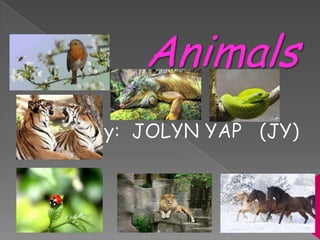
Jolynyap animals
- 2. Animals are divided into groups; mammals, birds, fish, reptiles, insects and anphibian. I will only be introducing animals in the groups mammals, birds and fish.
- 3. Characteristics of Mammals Has hair/fur Breathe through lungs Has 2 pairs of limbs Give birth to young alive Suckles its young Example: Lion, Zebra, Giraffe
- 4. Has scales Has a tail and a fin Breathe through gills Lays eggs Examples: Goldfish, Clownfish
- 5. Has feathers Lays eggs Has 2 legs Has a beak Has a pair of wings Examples: Koel, Asian Blue Fairy Bird
- 6. Carnivores are animals that eat meat only. Herbivores are animals that eat plants only. Omnivores are animals that eats both plants and animals.
- 7. • Whales are mammals that live in water. They still breathe through lungs. • Another name for Killer Whale is occar. • Whales uses their blowhole to breathe. • They are the largest animal in the world
- 8. Whales look like fishes but they are huge mammals.
- 9. Dolphins are similar to whales, they breathe through lungs.
- 10. Elephants are the largest land animal. Mammoths are the ancestors of elephant.
- 11. Tigers are dangerous animals. They are carnivorous.
- 12. Playtypus lays eggs. But they are still classified as mammals. Why? See the checklist below. Platypus …. Has hair/fur Has 2 pairs of limbs Suckle its young Breathe through lung Give birth to young alive
- 13. Anteaters are mammals. They have a long tongue Let’s see the checklist below. Anteaters…. Has hair/fur Has 2 pairs of limbs Suckle its young Breathe through lungs Give birth to young alive
- 14. Spiny anteaters are different from other anteaters, find out why in the checklist below. Has hair/fur Has 2 pairs of limbs Suckle its young Breathe through lungs Give birth to young alive
- 15. Sharks are fishes . They are carnivorous. Some sharks lays eggs and some give birth to young alive.
- 16. Molly fish and guppy fish are special fishes as they lay eggs.
- 18. Koel is a type of bird that have red beady eyes. It is found around the asia. Male Female
- 19. The Asian Fairy Bluebird eats fruit, nectar and some insects. The male has glossy, iridescent blue upperparts, and black underparts and flight feathers. The female and first year male are entirely dull blue- green.
- 20. THANK YOU I hope you enjoyed it !! Thank you for your time